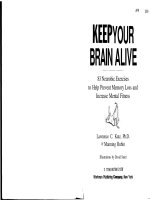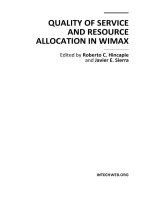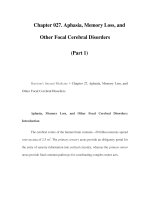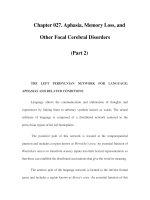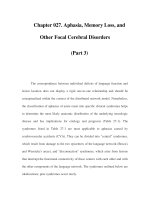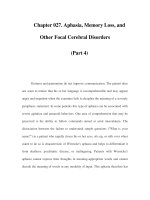Chapter 027. Aphasia, Memory Loss, and Other Focal Cerebral Disorders (Part 1) pdf
Bạn đang xem bản rút gọn của tài liệu. Xem và tải ngay bản đầy đủ của tài liệu tại đây (79.97 KB, 5 trang )
Chapter 027. Aphasia, Memory Loss, and
Other Focal Cerebral Disorders
(Part 1)
Harrison's Internal Medicine > Chapter 27. Aphasia, Memory Loss, and
Other Focal Cerebral Disorders
Aphasia, Memory Loss, and Other Focal Cerebral Disorders:
Introduction
The cerebral cortex of the human brain contains ~20 billion neurons spread
over an area of 2.5 m
2
. The primary sensory areas provide an obligatory portal for
the entry of sensory information into cortical circuitry, whereas the primary motor
areas provide final common pathways for coordinating complex motor acts.
The primary sensory and motor areas constitute 10% of the cerebral cortex.
The rest is subsumed by unimodal, heteromodal, paralimbic, and limbic areas,
collectively known as the association cortex (Fig. 27-1).
The association cortex mediates the integrative processes that subserve
cognition, emotion, and behavior. A systematic testing of these mental functions is
necessary for the effective clinical assessment of the association cortex and its
diseases.
Figure 27-1
Lateral (top) and medial (bottom) views of the cerebral hemispheres.
The numbers refer to the Brodmann cytoarchitectonic designations. Area 17
corresponds to the primary visual cortex, 41–42 to the primary auditory cortex, 1–
3 to the primary somatosensory cortex, and 4 to the primary motor cortex. The rest
of the cerebral cortex contains association areas.
AG, angular gyrus; B, Broca's area; CC, corpus callosum; CG, cingulate
gyrus; DLPFC, dorsolateral prefrontal cortex; FEF, frontal eye fields (premotor
cortex); FG, fusiform gyrus; IPL, inferior parietal lobule; ITG, inferior temporal
gyrus; LG, lingual gyrus; MPFC, medial prefrontal cortex; MTG, middle temporal
gyrus; OFC, orbitofrontal cortex; PHG, parahippocampal gyrus; PPC, posterior
parietal cortex; PSC, peristriate cortex; SC, striate cortex; SMG, supramarginal
gyrus; SPL, superior parietal lobule; STG, superior temporal gyrus; STS, superior
temporal sulcus; TP, temporopolar cortex; W, Wernicke's area.According to
current thinking, there are no centers for "hearing words," "perceiving space," or
"storing memories." Cognitive and behavioral functions (domains) are coordinated
by intersecting large-scale neural networks that contain interconnected cortical
and subcortical components.
The network approach to higher cerebral function has at least four
implications of clinical relevance: (1) a single domain such as language or
memory can be disrupted by damage to any one of several areas, as long as these
areas belong to the same network; (2) damage confined to a single area can give
rise to multiple deficits, involving the functions of all networks that intersect in
that region; (3) damage to a network component may give rise to minimal or
transient deficits if other parts of the network undergo compensatory
reorganization; and (4) individual anatomic sites within a network display a
relative (but not absolute) specialization for different behavioral aspects of the
relevant function.
Five anatomically defined large-scale networks are most relevant to clinical
practice: a perisylvian network for language; a parietofrontal network for spatial
cognition; an occipitotemporal network for face and object recognition; a limbic
network for retentive memory; and a prefrontal network for attention and
behavior.

